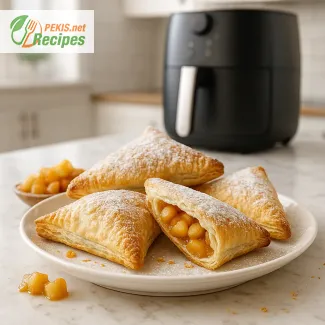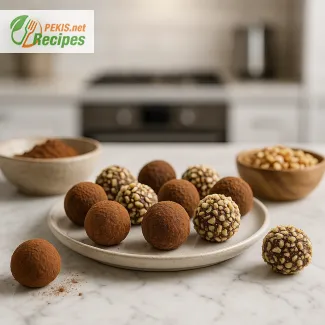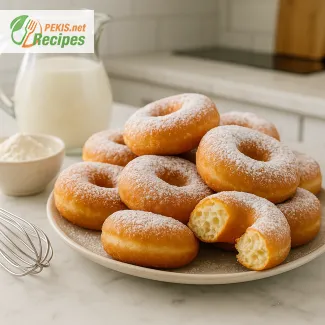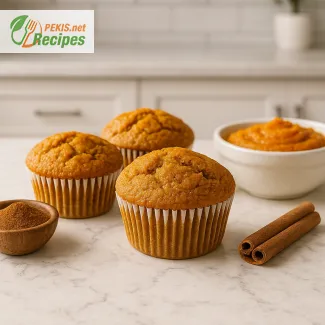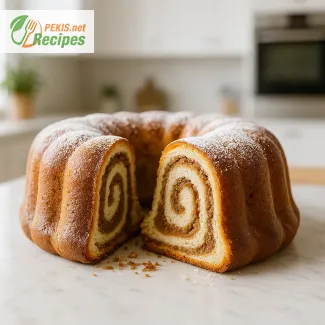
Traditional Neapolitan Easter Pie with Ricotta and Wheat
A beloved dessert symbolizing spring, family, and Italian culinary heritage
Italian Pastiera Napoletana is far more than just a pie—it's a celebration of tradition, culture, and the flavors of spring. Deeply rooted in Neapolitan Easter customs, this timeless dessert combines a fragrant wheat and ricotta filling with delicate hints of citrus, orange blossom water, and warm spices, all embraced by a buttery shortcrust pastry. Known for its unique texture and aromatic profile, the Pastiera is not just enjoyed—it's experienced, often prepared days in advance to allow its complex flavors to meld and deepen.
This iconic Southern Italian dessert hails from the heart of Naples and holds a revered place in Easter festivities across Italy. Its origins trace back to ancient times, where symbolic ingredients such as cooked wheat (grano cotto), eggs, and ricotta cheese were associated with rebirth, fertility, and abundance. The pie’s golden hue and delicate scent are reminiscent of the first days of spring, making it a perfect dessert to mark the end of Lent and the celebration of new beginnings.
What makes Pastiera truly exceptional is the interplay of textures: the slight bite of softened wheat grains, the silky creaminess of fresh ricotta, and the contrast of crisp pastry shell. Enhanced by candied orange peels, vanilla, and aromatic flower waters, each bite offers a taste of centuries-old Italian artistry. The filling is rich but not heavy, sweet but never cloying—offering a harmonious balance that has enchanted generations of Italians and food lovers worldwide.
Traditionally, the Pastiera is made during Holy Week, baked on Maundy Thursday or Good Friday so that it can rest and develop its flavors until Easter Sunday. Some families insist it must sit for at least two to three days before being served, as the mingling of ingredients creates the perfect aroma and consistency. This resting period is almost as sacred as the recipe itself and speaks to the Italian appreciation for slow, thoughtful preparation.
Pastiera is often baked in a distinctive fluted pan, with a crisscross lattice of dough on top, symbolizing the sun’s rays or Christian cross. Its unmistakable perfume—an ethereal mix of cinnamon, citrus zest, and orange blossom water—fills the kitchen with a sense of home, family, and celebration. This pie is rarely eaten alone; it is meant to be shared, sliced thickly, and enjoyed alongside a conversation, espresso, or a glass of dessert wine.
Though some variations exist—particularly in the use of different citrus peels or flavorings—true Pastiera adheres to a sacred combination of ingredients. Its preparation is often passed down through generations, with each family guarding their specific tweaks or rituals. Whether it's the choice of grano cotto brand, the preferred type of ricotta, or the exact timing of resting, every step holds deep meaning.
Today, the Pastiera is enjoyed well beyond the Campania region. In cities from Rome to Palermo, and even in Italian communities abroad, this pie appears in bakeries and homes around Eastertime as a symbol of nostalgia, identity, and culinary pride. It has also gained admiration from chefs and pastry lovers around the globe who are drawn to its rich history and unique flavor profile.
For those looking to recreate a genuine taste of Naples at home, Pastiera Napoletana offers not only a delicious dessert but also a beautiful culinary journey through Italian tradition. Whether you're baking it as part of your Easter menu, exploring classic Italian sweets, or simply craving something soulful and symbolic, this recipe invites you into a world where food and heritage are joyfully intertwined.
Prepare to fall in love with the gentle sweetness, the intoxicating aroma, and the story behind this timeless pie—a dish that, even after centuries, continues to bring families together around the Easter table.
Preparation steps – shortcrust pastry:
- In a large mixing bowl, combine flour, sugar, and salt. Add cold, cubed butter and rub between your fingertips or use a pastry cutter until mixture resembles coarse crumbs.
- Add the eggs and lemon zest. Knead briefly until the dough comes together into a smooth ball.
- Wrap in plastic wrap and refrigerate for at least 30 minutes while preparing the filling.
Preparation steps – filling:
- In a saucepan, combine the cooked wheat, milk, and butter. Simmer gently over low heat, stirring regularly, for 10–15 minutes until creamy. Let cool to room temperature.
- In a separate bowl, whisk together ricotta, sugar, whole eggs, egg yolks, citrus zests, vanilla, orange blossom water, and cinnamon until smooth.
- Fold in the cooled wheat mixture and candied orange peel until well combined. The filling should be rich, creamy, and aromatic.
Assembling and baking:
- Preheat the oven to 180°C (350°F). Grease a 24 cm (9.5-inch) fluted tart pan with butter.
- Roll out ⅔ of the chilled dough on a floured surface and line the prepared pan, trimming any excess.
- Pour in the filling and smooth the top.
- Roll out the remaining dough and cut into strips. Arrange them in a lattice pattern over the filling.
- Bake for approximately 60 minutes, until the filling is set and the crust is golden brown.
- Allow to cool completely, then let it rest at room temperature for at least 24 hours before serving. Dust with powdered sugar before serving if desired.
Creative Enhancements for a Timeless Neapolitan Easter Pie
Modern tips and ingredient swaps to refine the classic Pastiera Napoletana
Pastiera Napoletana, a dessert deeply intertwined with Neapolitan Easter tradition, has remained largely unchanged for centuries. However, modern palates and evolving culinary techniques open the door for subtle yet meaningful improvements that respect the dessert’s origins while enhancing its flavor, texture, and nutritional value. From ingredient upgrades to preparation techniques, there are many ways to refine this beloved pie without losing its soul.
Elevating flavor with premium ingredients
One of the most effective ways to improve Pastiera is to invest in the highest quality ingredients. Traditional ricotta can be elevated by using sheep’s milk ricotta, which has a richer and creamier texture than the more common cow’s milk variety. This simple swap deepens the flavor and makes the filling more velvety.
Another flavor upgrade comes from the wheat base. While cooked wheat in jars is convenient, preparing your own wheat berries from scratch allows for better texture control and a nuttier flavor. Soaking and gently simmering wheat berries with a touch of lemon peel and vanilla before integrating them into the pie results in a more aromatic and vibrant filling.
Adding complexity through flavor infusions
Traditional Pastiera is already fragrant with orange blossom water and citrus zest, but adding a touch of limoncello or grand marnier to the filling brings a sophisticated depth and a subtle boozy kick that enhances the citrus profile.
To introduce a floral nuance, some modern bakers add a dash of rose water or lavender essence—but sparingly. These additions can offer a unique twist without overwhelming the pie's identity.
Spices also offer room for experimentation. While cinnamon is a staple, try complementing it with a pinch of ground cardamom or nutmeg to add warmth and dimension to the filling.
Crust upgrades for texture and taste
The traditional pasta frolla crust can be enriched by replacing part of the all-purpose flour with almond flour. This addition contributes a nutty undertone and results in a more tender and flavorful crust.
Another tip is to use cold brown butter instead of plain unsalted butter. Brown butter adds a slightly caramelized, nutty aroma that deepens the flavor of the crust and pairs beautifully with the sweet filling.
For an extra crisp result, chill the lined tart pan before filling, and consider brushing the crust with egg white before baking to prevent sogginess.
Why homemade beats store-bought
Though Pastiera is widely available in bakeries across Southern Italy during Easter, making it at home allows for complete control over ingredients and preparation. Homemade versions typically feature fresher ricotta, less processed wheat, and the ability to adjust sweetness to personal preference.
Moreover, preparing it at home offers the opportunity to let the pie rest for a full 24–48 hours, a step often skipped in mass-produced versions. This resting time allows the flavors to mature and blend into the signature aromatic richness that defines the best Pastiera.
Avoiding common mistakes
One of the biggest mistakes is using wet or grainy ricotta. Always drain ricotta thoroughly for a smooth, dense filling. If your ricotta is too moist, strain it in cheesecloth overnight in the fridge.
Another error is overmixing the filling, which can lead to a loose or curdled texture. Gently folding ingredients preserves the creamy consistency and prevents air bubbles that can crack the surface during baking.
Improper lattice work can also affect the presentation and baking. Roll the strips evenly and don’t press them into the filling—let them rest gently across the surface to avoid sinking.
Healthier alternatives without sacrificing tradition
For those seeking a lighter version, substitute part of the sugar with erythritol or coconut sugar, both of which reduce the glycemic load while retaining sweetness.
Instead of full-fat dairy, consider part-skim ricotta or a blend of ricotta and Greek yogurt to cut back on saturated fats while maintaining a creamy consistency.
The wheat component can be replaced with quinoa or millet for a gluten-free alternative, as long as it's cooked to a tender, creamy texture. These grains mimic the mouthfeel of cooked wheat and absorb flavor well.
For the crust, opt for whole wheat pastry flour to boost fiber content while still preserving tenderness. Coconut oil can be used in place of butter for a dairy-free version, though this will slightly change the flavor profile.
Enhancing texture through technique
Texture is key in Pastiera. To prevent a dense pie, whip the egg whites separately and fold them into the filling last. This adds a lightness to the pie that many traditional versions lack.
To ensure the crust doesn't become soggy, use a ceramic or metal tart pan with a removable bottom, which promotes even browning and allows for easy release without damaging the structure.
Flavor pairings and serving enhancements
Pastiera is traditionally served plain or dusted with powdered sugar, but a modern touch could be a light citrus glaze or a spoonful of orange-infused mascarpone cream on the side.
For wine pairings, offer a glass of Vin Santo or Moscato d’Asti to complement the sweetness and aromatic intensity of the pie.
Personalizing your Pastiera
Though many families guard their Pastiera recipe as sacred, there’s nothing wrong with making it your own. Consider mixing in pistachios, dried figs, or hazelnuts for texture. You can also experiment with savory crusts flavored with rosemary or thyme to provide contrast to the sweet, floral filling.
Vegan versions are possible too—using plant-based ricotta made from almonds or tofu, and egg replacers such as aquafaba or commercial egg substitutes. Though the flavor will differ from traditional Pastiera, it still pays homage to its symbolic role on the Easter table.
By understanding and respecting the core structure of Pastiera Napoletana, while embracing modern creativity and ingredient diversity, it’s possible to honor tradition and create a version tailored to contemporary tastes—rich in flavor, history, and personal expression.
- Gluten (wheat flour, cooked wheat)
- Eggs
- Milk (ricotta, butter, milk)
Substitution tips for allergens and gluten:
- Gluten-free version: Replace all-purpose flour with a gluten-free flour blend suitable for pastry and use gluten-free cooked wheat substitute such as rice or millet.
- Dairy-free version: Substitute ricotta with lactose-free or plant-based ricotta alternative, butter with vegan margarine, and milk with almond or oat milk.
- Egg-free version: Use egg replacer powder or flax eggs (1 tbsp ground flax + 3 tbsp water = 1 egg) for each egg, though consistency may vary slightly.
- Calcium: 110 mg – supports bone and dental health
- Phosphorus: 180 mg – vital for energy metabolism and bone structure
- Vitamin A: 300 µg – important for vision and immune function
- Vitamin D: 0.8 µg – contributes to calcium absorption and bone health
- Vitamin B12: 0.9 µg – essential for nerve function and red blood cell formation
- Iron: 1.5 mg – important for oxygen transport and energy levels
- Magnesium: 25 mg – aids in muscle function and energy production
- Citrus flavonoids: 25 mg – anti-inflammatory and supports vascular health
- Carotenoids (from eggs): 150 µg – supports eye health and immune function
- Phenolic compounds (from wheat and cinnamon): 30 mg – help reduce oxidative stress and protect cells
